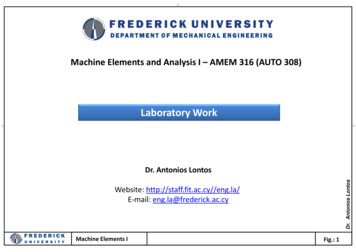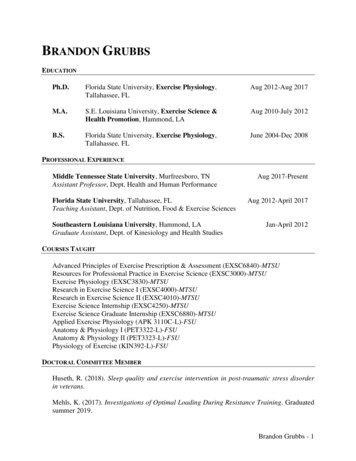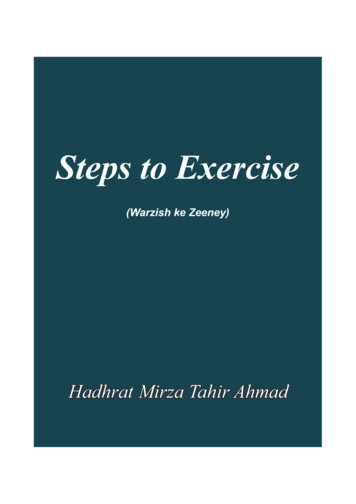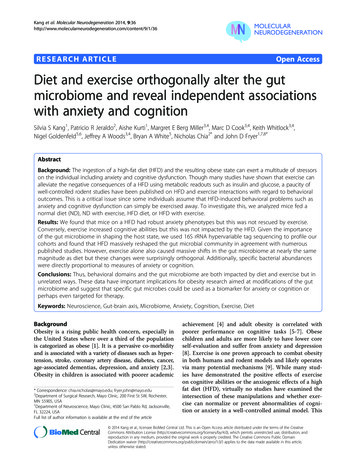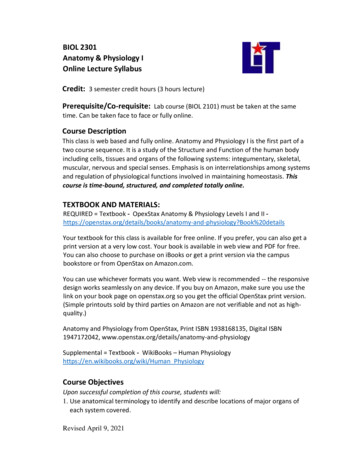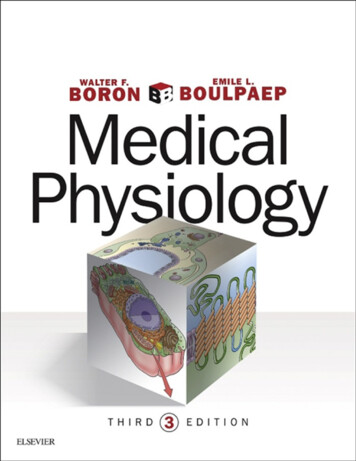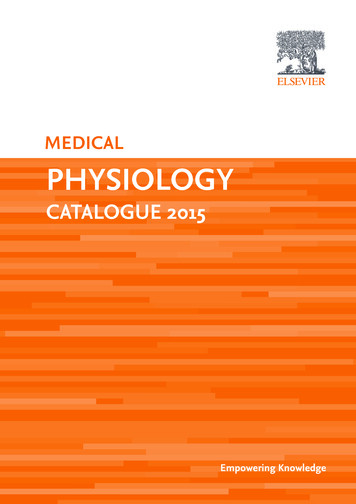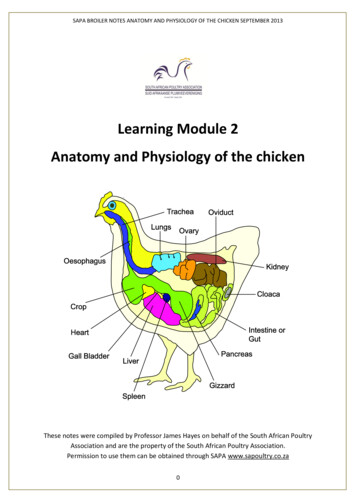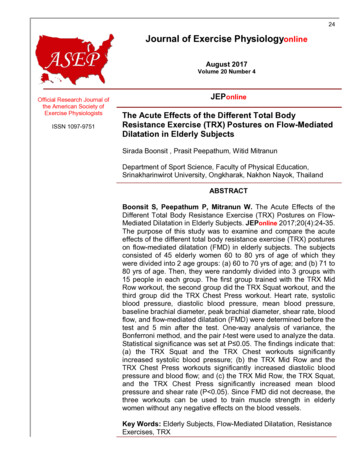
Transcription
24Journal of Exercise PhysiologyonlineAugust 2017Volume 20 Number 4Editor-in-ChiefOfficial Research Journal ofthe AmericanSocietyofTommyBoone, PhD,MBAReviewBoardExercisePhysiologistsTodd Astorino, PhDISSN 1097-9751Julien Baker,PhDSteve Brock, PhDLance Dalleck, PhDEric Goulet, PhDRobert Gotshall, PhDAlexander Hutchison, PhDM. Knight-Maloney, PhDLen Kravitz, PhDJames Laskin, PhDYit Aun Lim, PhDLonnie Lowery, PhDDerek Marks, PhDCristine Mermier, PhDRobert Robergs, PhDChantal Vella, PhDDale Wagner, PhDFrank Wyatt, PhDBen Zhou, PhDOfficial Research Journalof the American Society ofExercise PhysiologistsISSN 1097-9751JEPonlineThe Acute Effects of the Different Total BodyResistance Exercise (TRX) Postures on Flow-MediatedDilatation in Elderly SubjectsSirada Boonsit , Prasit Peepathum, Witid MitranunDepartment of Sport Science, Faculty of Physical Education,Srinakharinwirot University, Ongkharak, Nakhon Nayok, ThailandABSTRACTBoonsit S, Peepathum P, Mitranun W. The Acute Effects of theDifferent Total Body Resistance Exercise (TRX) Postures on FlowMediated Dilatation in Elderly Subjects. JEPonline 2017;20(4):24-35.The purpose of this study was to examine and compare the acuteeffects of the different total body resistance exercise (TRX) postureson flow-mediated dilatation (FMD) in elderly subjects. The subjectsconsisted of 45 elderly women 60 to 80 yrs of age of which theywere divided into 2 age groups: (a) 60 to 70 yrs of age; and (b) 71 to80 yrs of age. Then, they were randomly divided into 3 groups with15 people in each group. The first group trained with the TRX MidRow workout, the second group did the TRX Squat workout, and thethird group did the TRX Chest Press workout. Heart rate, systolicblood pressure, diastolic blood pressure, mean blood pressure,baseline brachial diameter, peak brachial diameter, shear rate, bloodflow, and flow-mediated dilatation (FMD) were determined before thetest and 5 min after the test. One-way analysis of variance, theBonferroni method, and the pair t-test were used to analyze the data.Statistical significance was set at P 0.05. The findings indicate that:(a) the TRX Squat and the TRX Chest workouts significantlyincreased systolic blood pressure; (b) the TRX Mid Row and theTRX Chest Press workouts significantly increased diastolic bloodpressure and blood flow; and (c) the TRX Mid Row, the TRX Squat,and the TRX Chest Press significantly increased mean bloodpressure and shear rate (P 0.05). Since FMD did not decrease, thethree workouts can be used to train muscle strength in elderlywomen without any negative effects on the blood vessels.Key Words: Elderly Subjects, Flow-Mediated Dilatation, ResistanceExercises, TRX
25INTRODUCTIONThe number of older people in Thailand has dramatically increased and most seniors havemore health problems than people in other age groups. The most common diseases in theelderly are hypertension, diabetes mellitus, and heart disease (20,33). In particular, theelderly experience vascular diseases, which are caused by decreased vascular elasticity,increased thickness, narrowing lumen diameter, and increased hardening of blood vessels(2,23,34).In general, the functional evaluation of the blood vessels is divided into 2 methods: (a) aninvasive method (17) that involves the puncturing or the insertion of a medical instrument intothe body; and (b) a non-invasive method (16,24) that is the measurement at the level of theskin and does not require venipuncture. An example of the latter is flow-mediated dilatation(FMD), which is the measurement of changes in the arterial diameter from stimuli such aspost-occlusive reactive hyperemia (PORH) by cuff inflation from a blood pressure monitor.The value of FMD represents the change in the diameter of the brachial artery fromincreasing shear stress. Of particular importance is the awareness of a reduction in FMD thatprecedes development of arterial stenosis, arteritis, atherosclerosis, and hypertension(2,23,34).When compared with young adults, older adults have decreased FMD due to decreasedvascular endothelial function. The production of nitric oxide decreases, while the productionof Endothelin-1 (ET-1) and the Endothelium Depolarization Factor (EDF) increases (1,35).The most common cofactors that decrease FMD are cigarette smoking, radiation therapy,obesity or being overweight, hypertension, hyperlipidemia, diabetes, medication (25), stress,genetics, and exercise (27,28,34). Conversely, aside from the physiologic benefits of ahealthy lifestyle, older adults should also engage in regular aerobic exercise and/or long-termresistance exercise to increase FMD (19,31,36).Yet, in regards to resistance exercise, interestingly, Bertovic et al. (2) and Miyachi et al. (23)reported that consistent resistance exercise training increased arterial stiffness in middleaged adults. In 2015, Mitranun and Phongsri (21) and then in 2016, Mitranun (22) reportedthat resistance training in the form of a 30-second plank and side crunch training did notproduce a change in the subjects’ FMD, while 60-second plank training and leg raise trainingacutely decreased FMD. Hence, the different types of resistance training might contribute tothe difference in the change in FMD.Total Body Resistance Exercise (TRX) is an exercise that uses body weight as a resistanceforce. Using TRX suspension training, Gaedtke and Morat (9) found that a 12-wk whole-bodysling training program restored the physical abilities of healthy older adults. Research byFong et al. (8) investigated core muscle activation during TRX training in adults with chroniclow back pain. Dawes and Melrose (6) evaluated the percentages of body mass resistanceexperienced by users of the TRX suspension training system (STS) at different angles anddistances from the hanging point. Gaedtke and Morat (9) developed and evaluated thefeasibility of a TRX suspension training program for healthy older adults.But, there appears to be no studies regarding the acute effects of different workouts of TRXresistance exercise on FMD. Therefore, in this study, we studied three workouts of TRX
26resistance exercise: (a) the TRX Mid Row workout that focused primarily on chest muscletraining; (b) the TRX Squat workout that trained primarily the leg muscles; and (c) the TRXChest Press workout that worked predominantly for back muscles. Each workout emphasizedthe large muscles of the body and what the acute effects may be in the elderly women. Theresults from the study should allow for a recommendation as to the appropriate workout ofTRX resistance exercises in older subjects.METHODSSubjectsThe subjects consisted of 45 elderly women 60 to 80 yrs of age who were selected from asenior club of Ratchawarin Temple, Bukkhalo Sub-district, Thon Buri District, Bangkok. Theyhad not participated in a systemic exercise training program during the 6 months prior to thisstudy getting underway. Each subject achieved a passing score of 10 to 20 on the BarthelActivities of Daily Living questionnaire and a passing score of 40 to 48 on the Oxford KneeScore questionnaire. The subjects were willing to participate in the research of which eachsubject agreed to sign a consent form to participate. The subjects were divided into 2 agegroups: (a) 60 to 70 yrs of age; and (b) 71 to 80 yrs of age. After that, they were randomlydivided into 3 groups with 15 subjects in each group. The first group trained with the TRX MidRow workout, the second group did the TRX Squat workout, and the third group did the TRXChest Press workout. The size of the target group was determined by G*Power software witha power analysis of 0.8 and an effect size of 0.5. This study received approval for humansubjects’ research from the Human Research Ethics Committee, the Strategic Wisdom andResearch Institute, Srinakharinwirot University with the code number SWUEC-358/59E.ProceduresExerciseThe exercise started with a warm-up. The subjects were told to walk fast for 10 min. Then,stretching exercises were done for 5 min to increase the flexibility of joints and muscles. TRXresistance exercise is an exercise workout that focuses on large muscles, including the chest,back, and leg muscles, such as: (a) the TRX Chest Press workout; (b) the TRX Mid Rowworkout; and (c) the TRX Squat workout, respectively.TRX Chest PressThe subjects were told to drop to their knees (using a yoga mat to support the knees) at theanchor point. Grab with both hands the suspended bands. Place the knees shoulder-widthapart. Take a breath and lean forwards until the thighs are at a 45 angle to the floor with thearms stretching straight. This is the starting position. Breathe out. Slowly move the chestdown and bend the elbows at a 90 angle. Keep both hands at the chest level for 3 sec.Then, stretch the arms out and pull the body up to return to the starting position. Perform 3sets. The subjects’ number of repetitions was determined to be 60% of their maximumrepetition (the number of times) and, then they rested for 1 min between sets. After that, the 3target groups underwent training of their own group’s workout. Before the training, eachsubject found out the number of repetitions at 100% of the maximum repetition, and beforethe real training for 72 hrs. Then, the number of repetitions was determined to be 60% of themaximum repetition. The subjects’ performed 3 sets and rested for 1 min between sets.Afterward, the muscles were relaxed by a cool down for 1 min.
27TRX Mid RowThe subjects were told to stand straight at the anchor point as both hands grabbed thehandles of the suspended bands. Place the feet shoulder-width apart. Then, take a breathand lean backwards until the body is at a 45 angle to the floor with the arms stretchingstraight. This is the starting position. Breathe out and slowly pull the body upwards. Keep thearms close to the sides for 3 sec. After that, stretch the arms out and return to the startingposition. Perform 3 sets. The number of repetitions was determined to be 60% of themaximum repetition. The subjects’ performed 3 sets and rested for 1 min between sets.TRX SquatThe subjects were told to stand 80 cm from the anchor point. Grab the suspended bands withboth hands. Extend both arms forwards so that both arms are stretched straight. Bend bothknees and drop the hip backwards. Bear the weight on the thighs and buttocks until thethighs are parallel with the floor (try to keep your shin vertical), and the knees do not movebeyond the tips of the toes. Then, lean backwards very slightly. This is the starting position.Take a breath and slowly pull the hips back by tensing the legs. Keep the arms close to thesides for 3 sec. Breathe out and slowly bend the knees to return to the starting position.Perform 3 sets. The number of repetitions was determined to be 60% of the maximumrepetition. The subjects’ performed 3 sets and rested for 1 min between sets.Flow-Mediated Dilatation Measures (FMD)Measures of blood vessels variables were done using an ultrasound device (Ultrasound EchoGe; Vivid-I model from the United States of America). Before the measures were done, thesubjects laid down to rest for 20 min. Then, blood pressure and the FMD of the brachialartery were measured by using the cuff of a blood pressure monitor to wrap around the rightforearm during the entire test. An image of the brachial artery at the antecubital fossa wasrecorded in a longitudinal plane. The recording of an image and a video was done 1 minbefore cuff inflation. After inflating the cuff until the pressure was 50 mmHg higher than thesystolic blood pressure of each subject (21,26), the cuff was inflated to remain at thatpressure for 5 min. An image and a video were recorded throughout the cuff inflation.Accordingly, the cuff was deflated rapidly, likewise, an image and a video were continuouslyrecorded after deflation for 5 min (3,16,21,22). The recording of the image and video of thesize of blood vessels were done by using B-mode.Mean blood velocity during the data collection from the ultrasound device was analyzed indoppler mode. Moreover, in order to reduce bias of the researcher in the analysis of imagesand videos, the Brachial Analyzer program was used to analyze the changes of brachialartery diameter. Shear stress was calculated by performing [blood velocity brachialdiameter]. Flow-mediated dilatation (FMD) was calculated by performing [Peak brachialdiameter – baseline brachial diameter] x 100 baseline brachial diameter (21).Biological VariablesThe subjects’ age, weight, and height were measured using a spring scale and heightmeasurement scale (Health Meter). Body mass index was calculated while heart rate at rest,diastolic blood pressure, systolic blood pressure were determined using a digital bloodpressure monitor (MO701i model from the United States of America) before and after thetraining. Mean blood pressure was calculated by using the following formula: mean blood
28pressure 1/3 x [systolic blood pressure – diastolic blood pressure] diastolic bloodpressure. In addition, TRX resistance training was conducted by using the TRX Pro3 model(from the United States of America).Questionnaire MeasurementsAll subjects were requested to fill out the Barthel Activities of Daily Living questionnaire andthe Oxford Knee questionnaire. The variables of blood vessels and blood pressure weremeasured before training and, then repeated within 5 min after training.Statistical AnalysesFrequency, percentage, means SD of the target group were analyzed and compared beforeand after training by using paired-t test. The difference between means before and acutelyafter the training was tested by one-way analysis of variance using Bonferroni’s test with thestatistical significance set at P 0.05.RESULTSTable 1 presents the subjects’ baseline values before doing the TRX resistance training ineach of the 3 training groups: (a) the TRX Mid Row workout; (b) the TRX Squat workout; and(c) the TRX Chest Press. Baseline variables included the number of elderly people, age,height, body weight, body mass index, heart rate at rest, systolic blood pressure, diastolicblood pressure, mean blood pressure, and the maximum repetitions before training. Thebaseline variables before the training of the subjects in each group did not differ significantly.However, baseline values of the subjects’ maximum repetitions when doing an exercise wassignificantly different.Table 1. Baseline Data of Subject Characteristics.Number (n)Age (yrs)Height (cm)Body Mass (kg)Body Mass Index (kg·m-2)Heart Rate at Rest (mmHg)Systolic Blood Pressure (mmHg)Diastolic Blood Pressure (mmHg)Mean Arterial Pressure (mmHg)Maximum Repetitions (reps)TRX Mid RowTRX SquatTRX Chest Press1568.25 5.22152.33 1.3857.48 2.4924.76 0.9773.25 1.34131.00 4.6077.50 2.8995.33 3.1343.25 3.011569.58 7.65151.00 1.8852.74 3.0223.11 1.2575.42 2.38129.92 3.6381.00 2.8797.31 2.8540.08 2.52*1569.25 7.10154.83 1.3856.71 2.7023.65 1.1374.00 3.55136.92 4.8979.00 2.5698.31 3.1524.83 1.70*Data are means SD. *P 0.05 vs. TRX Mid RowTable 2 presents the physiological changes in the subjects’ variables after training. Systolicblood pressure increased in the TRX Squat and TRX Chest Press workouts. On the otherhand, diastolic blood pressure and blood velocity increased in TRX Mid Row and TRX Chest
29Press workouts (P 0.05). Mean blood pressure and shear stress increased in all 3 workouts(P 0.05). There was no statistically significant change in the baseline and peak brachialdiameter in all 3 workouts.Table 2. Brachial Characteristics and Blood Pressure Data.TRX Mid RowTRX SquatTRX Chest elineAfterTrainingBaselineBrachialDiameter (mm)4.45 0.154.45 0.154.28 0.124.28 0.124.39 0.164.39 0.16Peak BrachialDiameter (mm)4.51 0.184.55 0.174.66 0.154.59 0.134.75 0.254.85 0.24Shear Rate(s-1)20.21 4.2425.01 4.47*20.44 3.5925.84 4.50*20.86 3.3825.52 4.31*Blood Flow(ml·min-1)253.39 42.84308.48 48.44*224.63 40.78258.64 46.12258.07 32.85320.82 48.39*Systolic BloodPressure(mmHg)131.00 4.60137.50 6.79129.92 3.63137.17 4.19*136.92 4.89148.92 5.47*DiastolicBloodPressure(mmHg)77.50 2.8983.83 2.71*81.00 2.8783.25 2.8179.00 2.5686.42 2.00*Mean ArterialPressure(mmHg)95.33 3.13101.72 3.54*97.31 2.85101.22 2.96*98.31 3.15107.25 2.76*Heart Rate(beat·min-1)73.25 1.3475.83 2.2975.41 2.3879.00 2.72*74.00 3.5578.42 3.45*Data are mean SD. *P 0.05 vs. BaselineFigure 1 compares flow-mediated dilatation (FMD) within each group before and after thetraining, as well as between the groups. In this study, FMD did not change in the 3 traininggroups and between the training groups.
30Figure 2. Flow-Mediated Dilatation in the 3 Training Groups and Between the TrainingGroups.DISCUSSIONTotal Body Resistance Exercise (TRX) is an exercise training program in which the individualusing his or her body weight as the resistant force. Two nylon straps are hung on a pole or awall and then used in different types of exercises (i.e., workouts). The training weight can beincreased by adjusting the length of a strap or by changing the angle of the workout. TheTRX training program with straps can increase the strength of the muscles of the arms, legs,and core (4,8,10,30). It can increase strength in adults with hypertension, diabetes mellitus,rheumatoid arthritis, scoliosis, herniated disc, and hypercholesterolemia (9). TRX training isalso helpful in increasing balance in elderly adults (10) and promoting mental health and wellbeing among seniors (9). However, to our understanding, there are no studies that haveexamined the acute effects of a TRX training program on blood vessels.Flow-mediated dilatation (FMD) is the measurement of changes in blood vessel diameter bystimulation with Post-Occlusive Reactive Hyperemia (PORH) through cuff inflation from ablood pressure monitor. This method reflects endothelial function. The vascular endotheliumcontrols the changes in the blood vessel diameter and blood flow. It also responds to stimuliproduced and secreted from blood vessels including vasodilators, such as Nitric Oxide (NO),Prostacyclin, Endothelium Derived Hyperpolarizing Factors (EDHF), and vasoconstrictors,such as Endothelin-1, Angiotensin II, Thromboxane A2, and Prostaglandin H2 (35). Low FMDincreases the risk of hypertension, hyperlipidemia, diabetes mellitus, and stress (27,28,34).Most elderly people have decreased FMD, when compared with other age groups because ofdecreasing vascular endothelial function. The production of nitric oxide decreases, while theproduction of Endothelin-1 (ET-1), Endothelium Depolarization Factor (EDF), and Endothelinsincrease (1). FMD of older people can be increased by exercise. From previous studies, FMDof seniors who do aerobic exercise consistently can be increased by 47%. Moreover, it canimprove the function of the heart and blood vessels (7). However, the effects of resistanceexercise on FMD are still controversial. Previous research reports include increasing results
31(21,22), decreasing results (13,15), and no change (15,21). For example, 60-sec planktraining (22) and leg raise training acutely decreased FMD (21); whereas, 30-sec planktraining (22) and side crunch training had no effect on FMD (21). It is possible that differentworkouts may affect the changes of FMD.However, the difference of physical abilities might impact the different changes of FMD aswell. The decrease in FMD after acute resistance training in people who regularly doresistance exercise is less than that of people who have not engaged in resistance exercise(15,26,29,32). Doing regular resistance exercise can help prevent an acute decrease of FMD(14,15,26,32). According to the results in the present study, TRX resistance exercise doesnot negatively affect the FMD of elderly women, although seniors have lower physical abilitiesand never exercise.Resistance exercise increases blood pressure more than aerobic exercise. The formerincreases blood pressure and decreases FMD (5,18). Thus, blood pressure is the majorfactor affecting FMD. This research finds that systolic blood pressure increases in the TRXSquat and the TRX Chest Press workouts. There was no change in the TRX Mid Rowworkout. Diastolic pressure increased only in the TRX Mid Row and the TRX Chest Pressworkouts, while there was no change in the TRX Squat workout. However, we may discussthe changes of blood pressure by using mean blood pressure, which is calculated by usingvariables including systolic blood pressure and diastolic blood pressure. The results indicatethat mean blood pressures during the 3 workouts was significantly increased. In the presentstudy, blood pressure did not impact the change in FMD.Shear rate is one factor that affects FMD (12). Shear rate is an indicator of shear stress oftraining. During exercise, the increase in blood flow contributes to an increase in shear stress(11) and the stimulation of vasoactive substances, such as nitric oxide (29). Previousresearch illustrates that after training shear rate increases and causes FMD to increase (29).The present research found that shear rate increased during the 3 workouts, but the increasein shear rate did not affect FMD.The findings in this study reveal that there are changes, including shear rate and bloodpressure. However, there was no change in the subjects’ FMD. Generally, the mechanismthat impacts FMD comes from changes related to vasodilation and vasoconstriction. Anincrease in shear rate comes from a mechanism related to vasodilatation, while an increasein blood pressure is a mechanism related to vasoconstriction. Therefore, the combination ofboth leads to no change in FMD. The research results show that TRX resistance trainingdoes not cause a negative effect on FMD in elderly women. This is in accordance withprevious work that proposed a concept of choosing a workout that does not have a negativeeffect on FMD (i.e., it does not decrease FMD) (21).CONCLUSIONSThe findings indicate that the 3 TRX resistance exercise workouts did not decrease FMD inthe elderly women. Therefore, the TRX Mid Row, the TRX Squat, and the TRX Chest Pressworkouts can be used to train muscle strength in elderly women without any negative effectson blood vessels.
32ACKNOWLEDGMENTSThis research was supported in laboratory equipments by Sport Science laboratory, Facultyof Physical Education, Srinakharinwirot University. We thank the subjects for participating inthis study.Address for correspondence: Witid Mitranun, PhD, Department of Sport Science, Facultyof Physical Education, Srinakharinwirot University, Ongkharak, Nakhon Nayok, Thailand,26120, Email: mitranunwitid@hotmail.comREFERENCES1. Bassenge E. Endothelial function in different organs. Prog Cardiovasc Dis. 1996;39(3):209-228.2. Bertovic DA, Waddell TK, Gatzka CD, Cameron JD, Dart AM, Kingwell BA. Muscularstrength training is associated with low arterial compliance and high pulse pressure.Hypertens. 1999;33(6):1385-1391.3. Betik AC, Luckham VB, Hughson RL. Flow-mediated dilation in human brachial arteryafter different circulatory occlusion conditions. Am J Physiol Heart Circ Physiol.2004;286(1):H442-H448.4. Calatayud J, Borreani S, Colado JC, Martín FF, Rogers ME, Behm DG, Andersen LL.Muscle activation during push-ups with different suspension training systems. JSports Sci Med. 2014;13(3):502.5. Cheetham C, Green D, Collis J, Dembo L, O'driscoll G. Effect of aerobic andresistance exercise on central hemodynamic responses in severe chronic heart failure.J Appl Physiol. 2002;93(1):175-180.6. Dawes J, Melrose D. Resistance characteristics of the TRX Suspension TrainingSystem at different angles and distances from the hanging point. J Athl Enhanc.2015;4(1):1-57. Desouza CA, Shapiro LF, Clevenger CM, Dinenno FA, Monahan KD, et al. Regularaerobic exercise prevents and restores age-related declines in endothelium-dependentvasodilation in healthy men. Circ. 2000;102(12):1351-1357.8. Fong SS, Tam YT, Macfarlane DJ, Ng SS, Bae Y, Chan EW, Guo X. Core muscleactivity during TRX suspension exercises with and without kinesiology taping in Adultswith chronic low back pain: Implications for rehabilitation. Evid Based ComplementAlternat Med. 2015;2015:1-6.
339. Gaedtke A, Morat T. TRX Suspension training: A new functional training approach forolder adults–development, training control and feasibility. Int J Exerc Sci. 2015;8(3):224.10. Gaedtke A, Morat T. Effects of two 12-week strengthening programmes on functionalmobility, strength and balance of older adults: Comparison between TRX suspensiontraining versus an elastic band resistance training. Cent Eur J Sport Sci Med. 2016;13:49-64.11. Green DJ, Maiorana A, O'driscoll G, Taylor R. Effect of exercise training onendothelium-derived nitric oxide function in humans. J Physiol. 2014;561(1):1-25.12. Gonzales JU, Thompson BC, Thistlethwaite JR, Scheuermann BW. Associationbetween exercise hemodynamics and changes in local vascular function followingacute exercise. Appl Physiol Nutr Metab. 2011;36(1):137-144.13. Gori T, Grotti S, Dragoni S, Lisi M, Stolfo GD, Sonnati S, Parker JD. Assessment ofvascular function: Flow-mediated constriction complements the information of flowmediated dilatation. Heart. 2009;96(2):141-147.14. Hwang I, Kim K, Choi W, Kim H, et al. Impact of acute exercise on brachial artery flowmediated dilatation in young healthy people. Cardiovasc Ultrasound. 2012;10(1):112.15. Jurva JW, Phillips SA, Syed AQ, Syed AY, et al. The effect of exertional hypertensionevoked by weight lifting on vascular endothelial function. J Am Coll Cardiol. 2006;48(3):588-589.16. Kuruppu JC, Corretti M, Mackowiak P, Roghmann M. Overuse of transthoracicechocardiography in the diagnosis of native valve endocarditis. Arch Intern Med.2002;162(15):1715.17. Lip G. Von Willebrand factor: A marker of endothelial dysfunction in vasculardisorders? Cardiovasc Res. 1997;34(2):255-265.18. MacDougall JD, McKelvie RS, Moroz DE, Sale DG, McCartney N, Buick F. Factorsaffecting blood pressure during heavy weight lifting and static contractions. J ApplPhysiol. 1992;73(4):1590-1597.19. Maiorana A, O'driscoll J, Dembo L, Goodman C, Taylor R, Green D. Effect ofcombined aerobic and resistance exercise training of functional capacity, bodycomposition and vascular function. J Am Coll Cardiol. 2001;38(3):860-866.20. Mendis S, Lindholm LH, Mancia G, Whitworth J, Alderman M, Lim S, Heagerty T.World Health Organization (WHO) and International Society of Hypertension (ISH) riskprediction charts: Assessment of cardiovascular risk for prevention and control ofcardiovascular disease in low and middle-income countries. J Hypertens. 2007;25(8):1578-1582.
3421. Mitranun W, Phongsri K. The acute effects on endothelial function in the differentabdominal training postures. Songklanakarin J Sci Technol. 2015;37:545-551.22. Mitranun W. The acute effects of short and long durations of plank training on theendothelial function. Songklanakarin J Sci Technol. 2016;38:1-7.23. Miyachi M, Donato AJ, Yamamoto K, Takahashi K, Gates PE, Moreau KL, Tanaka H.Greater age-related reductions in central arterial compliance in resistance-trainedmen. Hypertens. 2002;41(1):130-135.24. Morales F, Graaff R, Smit AJ, Bertuglia S, Petoukhova AL, Steenbergen W, RakhorstG. How to assess post-occlusive reactive hyperemia by means of laser Dopplerperfusion monitoring: Application of a standardized protocol to patients with peripheralarterial obstructive disease. Microvasc Res. 2005;69(1-2):17-23.25. O'brien J. Effects of salicylates on human platelets. Lancet. 1968;291(7546):779-783.26. Phillips SA, Das E, Wang J, Pritchard K, Gutterman DD. Resistance and aerobicexercise protects against acute endothelial impairment induced by a single exposureto hypertension during exertion. J Appl Physiol. 2011;110(4):1013-1020.27. Rinder MR, Spina RJ, Ehsani A. Enhanced endothelium-dependent vasodilation inolderendurance-trained men. J Appl Physiol. 2000;88:761-766.28. Rywik TM, Blackman MR, Yataco AR, Vaitkevicius PV, ZinkRC, Cottrell EH, WrightJG, Katzel LI, Fleg JL. Enhanced endothelial vasoreactivity in endurance trained oldermen. J Appl Physiol. 1999;87:2136-2142.29. Tinken TM, Thijssen DH, Hopkins N, Black MA, Dawson EA, Minson CT, Green DJ.Impact of shear rate modulation on vascular function in humans. Hypertens. 2009;54(2):278-285.30. Tomljanovic M, Spasic M, Gabrilo G, Uljevic O, Foretic N. Effects of five weeks offunctional vs. traditional resistance training on anthropometric and motor performancevariables. Kinesiol. 2011;43(2):145-154.31. Tjonna AE, Lee SJ, Rognmo O, Stolen TO, Bye A, Haram PM, Wisloff U. Aerobicinterval training versus continuous moderate exercise as a treatment for the metabolicsyndrome: A pilot study. Circ. 2008;118(4):346-354.32. Varady D. What should housing vouchers do? A review of the recent literature. J HousBuilt Environ. 2010;25(4):391-407.33. Vogel RA. The management of hypercholesterolemia in patients with coronary arterydisease: Guidelines for primary care. Clin Cornerstone. 1998;1(1):51-64.
3534. White RA. Atherosclerosis and Arteriosclerosis: Human Pathology andExperimental Animal Methods and Models. Boca Raton, FL: CRC Press, 1989.35. Widlansky ME, Gokce N, Keaney JF, Vita JA. The clinical implications of endothelialdysfunction. J Am Coll Cardiol. 2003;42(7):1149-1160.36. Wisloff U, Stoylen A, Loennechen JP, Bruvold M, Rognmo O, Haram PM, Skjaerpe T.Superior cardiovascular effect of aerobic interval training versus moderate continuoustraining in heart failure patients: A randomized study. Circ. 2007;115(24): 3086-3094.DisclaimerThe opinions expressed in JEPonline are those of the authors and are not attributable toJEPonline, the editorial staff or the ASEP organization.
stretching exercises were done for 5 min to increase the flexibility of joints and muscles. TRX resistance exercise is an exercise workout that focuses on large muscles, including the chest, back , and leg muscles, such as : (a ) the TRX Chest Press workout; (b) the TRX Mid Row workout; and (c ) the TRX Squat workout, respectively. TRX Chest Press


